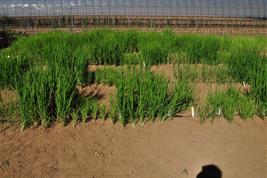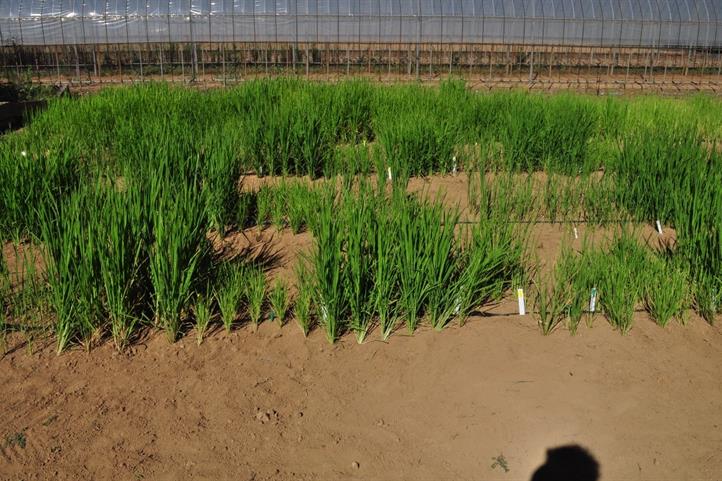10.08.2021

Rice is a staple food for more than half of the world's population. The majority of the world's rice harvest is grown as wet rice, i.e. on flooded fields. This has advantages, however it also produces high methane emissions and consumes a lot of water. Dry rice cultivation, i.e. growing rice on non-flooded fields, could be a climate-friendly alternative to wet rice cultivation, but has so far only be able to provide lower yields. A new international joint project coordinated by the Leibniz Centre for Agricultural Landscape Research (ZALF) is now investigating how yields could be increased. The project is funded by the German Research Foundation.
In addition to nitrogen, phosphorus is one of the most important nutrients for plant growth. In dry rice cultivation, however, the availability of phosphorus in the soil is often low. This is mainly because dry rice cultivation is particularly widespread in regions where few phosphorus fertilizers are available and phosphorus availability in the soil is low. Pronounced dry periods also contribute to phosphorus deficiency and thus to low yields. In order to increase rice yields in dry rice cultivation, it is therefore important to understand which processes improve the uptake of phosphorus by the root and to what extent different rice varieties differ in their ability to absorb phosphorus. A new DFG-funded research project, coordinated by the Leibniz Centre for Agricultural Landscape Research (ZALF), is looking for answers to this question. The research team is using elaborate methods of so-called rhizosphere research, in which root processes are examined at the smallest level.
The joint project "Small scale – big impact: Rhizosphere processes as the key to P uptake efficiency in dry rice cultivation" will run for three years. Together with the project partners from the University of Natural Resources and Life Sciences Vienna (BOKU) and the Japan International Research Center for Agricultural Sciences (JIRCAS), the project aims to investigate the extent to which biogeochemical processes of nutrient uptake in the soil around the plant root, in the so-called rhizosphere, are responsible for an increased uptake efficiency of phosphorus in different rice varieties. The project is coordinated by Dr. Maire Holz (ZALF), an expert in rhizosphere research.
Microorganisms can contribute to phosphorus uptake
At the root level, several processes can lead to an increase in phosphorus uptake by plants. First, various organic substances are secreted by the root into the soil, where they can increase the availability of phosphorus and alleviate drought stress. Whether this positive effect of root exudation can also be applied to dry rice cultivation is the question the joint project is now trying to answer. Another question is what influence microorganisms such as bacteria or mycorrhizal fungi can have on the availability of nutrients and water uptake in dry rice cultivation.
The fact that the properties of the roots and chemical processes in the root area can contribute to a better utilization of nutrients is already known, but so far it has hardly been possible to integrate them into plant breeding. This is due, among other things, to the often laborious procedures involved in rhizosphere research. Combining the expertise of ZALF scientist Dr. Maire Holz and Dr. Eva Oburger (BOKU Vienna) in rhizosphere process monitoring with the experience of Dr. Matthias Wissuwa (JIRCAS, Japan) in plant breeding will enable the project partners to address practical breeding issues for rice varieties which are suitable for dry rice cultivation. The results of the project should enable rhizosphere processes to be incorporated into breeding programs to maintain and improve yields in dry rice systems.
Project Partners
- Leibniz Centre for Agricultural Landscape Research (ZALF) (co-ordination)
- University of Natural Resources and Life Sciences, Vienna (BOKU)
- Japan International Research Center for Agricultural Sciences (JIRCAS)
Funding notice
The joint project is funded by the German Research Foundation (DFG) and the Austrian Science Fund (FWF).
 Press Release as PDF
Press Release as PDF
Further information
Pictures
For downloading the pictures please click on a picture and use the icon.


Dry rice cultivation in Japan: Different rice varieties show varying degrees of ability to uptake phosphorus as a nutrient. A new joint project is investigating which processes can improve the uptake of nutrients by plants in dry rice cultivation. Source: © Dr. Matthias Wissuwa / JIRCAS.
